NASHA LABA possibilities
Registration
Back to search results
Fluorescently labeled probes and samples
from
5 070 ₽
Manufacturer:
Genterra
Location:
Moscow
Empirical Formula:
-
CAS-number:
-
Reagent type:
Individual substance
Characteristics:
Applying:
from
5 070 ₽
Go to the manufacturer's website
Fluorescent probes are an oligonucleotide with a fluorescent label and a suppressor that can bind to the DNA chain during amplification. When the probe is in a free state, both dyes are located close to each other, therefore, fluorescence quenching occurs. During PCR, at the stage of chain elongation, the hybridized probe is cleaved by a polymerase that has 5’-exonuclease activity, the dyes are separated, and a fluorescent signal proportional to the amount of the amplified product is observed. The fluorescence intensity increases in each cycle in proportion to the probe splitting rate. The use of probes in PCR makes it possible to increase the accuracy and selectivity of the reaction.
A wide range of fluorescent dyes: FAM, R6G, VIC, HEX, JOE, TAMRA, ROX, Cy 5 and Cy5.5
The possibility of multiplex analysis of multiple DNA targets in one test tube.
High efficiency of PCR-RV.
Probe quality control: HPLC purification and mass spectrometry verification
A wide range of fluorescent dyes: FAM, R6G, VIC, HEX, JOE, TAMRA, ROX, Cy 5 and Cy5.5
The possibility of multiplex analysis of multiple DNA targets in one test tube.
High efficiency of PCR-RV.
Probe quality control: HPLC purification and mass spectrometry verification

5Х Genta Taq-AB qPCR мастер-микс, 250 реакций
from
2 500 ₽
5Х Genta Taq-AB qPCR мастер-микс – готовая к использованию смесь для проведения качественной или количественной ПЦР с возможностью детекции результатов в режиме реального времени.
5Х Genta Taq-AB qPCR мастер-микс содержит все необходимые для проведения ПЦР компоненты, включая полимеразу Genta Taq-AB, дНТФ, Mg2+, краситель SYBR Green I и реакционный буфер.
Для постановки реакции ПЦР в реакционную смесь необходимо добавить только олигонуклеотиды, матрицу и воду.
Инактивация полимеразы Genta Taq-AB помощью антител позволяет проводить подготовку смесей при комнатной температуре.
«Горячий» старт обеспечивает повышение специфичности амплификации. Диссоциация комплекса и высвобождение Genta Taq-AB ДНК-полимеразы обеспечивается прогреванием выше 70°C.
Гентерра
Москва
Produced in: Москва

5Х Genta qPCR мастер-микс, 250 реакций
from
1 600 ₽
5X Genta qPCR мастер-микс – готовая к использованию смесь для проведения качественной или количественной ПЦР с детекцией результатов в режиме реального времени.
Мастер-микс обеспечивает надежную работу ПЦР в широком спектре приложений. Мастер-микс позволяет проводить ПЦР-РВ в мультиплексном формате.
5X Genta qPCR мастер-микс содержит все необходимые для проведения ПЦР компоненты, включая полимеразу Genta TaqF, дНТФ, Mg2+, краситель SYBR Green I и реакционный буфер.
Для постановки реакции ПЦР в реакционную смесь необходимо добавить только олигонуклеотиды, матрицу и воду.
Химически инактивированная ДНК-полимераза Genta TaqF позволяет проводить подготовительные работы при комнатной температуре и обеспечивает высокоспецифичную амплификацию благодаря возможности проведения «горячего» старта.
Ингибирование активности фермента снимается при его прогревании при 95°C в течение 15 минут.
Гентерра
Москва
Produced in: Москва

5х Genta LAMP-буфер
from
78 ₽
5-кратный реакционный буфер, подходящий для использования в реакции изотермической амплификации нуклеиновых кислот в форматах LAMP и ОТ-LAMP.
Стандартный 5х Genta LAMP-буфер содержит 25 мМ MgSO4, что соответствует 5 мМ MgSO4 в реакционной смеси.
Гентерра
Москва
Produced in: Москва

Genta TaqF ДНК-Полимераза, 5 000 ед./мл
from
1 300 ₽
Genta TaqF ДНК-полимераза — химически модифицированный рекомбинантный аналог ДНК-полимеразы из термофильной бактерии Thermus aquaticus. Фермент обладает 5’-3’ полимеразной активностью и 5’-3’ экзонуклеазной активностью, но не имеет 3’-5’ корректирующую экзонуклеазную активность. Рекомбинантный фермент Genta TaqF ДНК-полимераза подходит для использования в рутинных ПЦР, включая ПЦР в режиме реального времени.
Genta TaqF ДНК-полимераза инактивирована с помощью химической модификации, что позволяет проводить приготовление реакционной смеси при комнатной температуре. Наличие «горячего старта» повышает специфичность и чувствительность амплификации. Активация полимеразы происходит при её прогревании до 95°C в течение 15 минут.
Гентерра
Москва
Produced in: Москва

Genta TaqF ДНК-Полимераза, 5 000 ед./мл, 1 000 ед.
from
3 900 ₽
Genta Bst ДНК-полимераза — большой фрагмент ДНК-полимеразы Bacillus stearothermophilus (полипептид размером 67 кДа). Фермент обладает 5’-3’ полимеразной активностью, но не имеет 5’-3’ и 3’-5’ экзонуклеазную активность. Genta Bst ДНК-полимераза обладает вытесняющей активностью и может использоваться для изотермической амплификации ДНК в формате LAMP/RT-LAMP.
Оптимальная температура активности фермента — 60-65°C.
Гентерра
Москва
Produced in: Москва
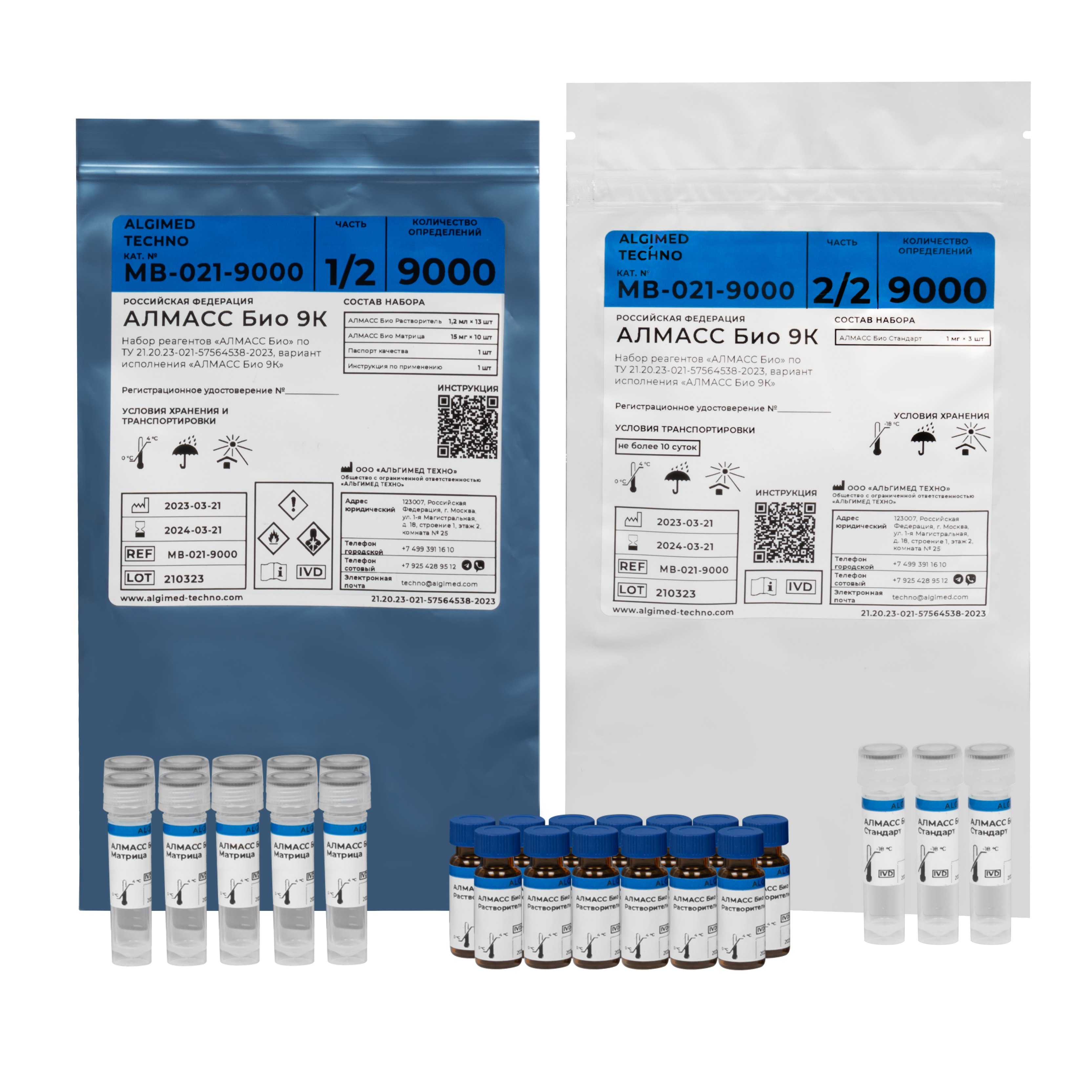
Набор реагентов «АЛМАСС Био», вариант исполнения «АЛМАСС Био 9К»
Набор реагентов «АЛМАСС Био», в варианте исполнения «АЛМАСС Био 9К» предназначен для подготовки образцов микроорганизмов 3-4 групп патогенности, выделенных из клинических образцов, при определении их видовой принадлежности, и для калибровки масс-спектрометров МАЛДИ-ВПМС в качестве вспомогательного средства диагностики in vitro инфекционных заболеваний населения.
Набор реагентов «АЛМАСС Био», в варианте исполнения «АЛМАСС Био 9К» содержит следующие компоненты: реагент «АЛМАСС Био Растворитель», реагент «АЛМАСС Био Стандарт» и реагент «АЛМАСС Био Матрица»:
- Реагент «АЛМАСС Био Стандарт» представляет собой очищенный белковый экстракт штамма Escherichia coli DH5 alpha, который демонстрирует при проведении масс-спектрометрического анализа типичный белковый профиль бактерии и применяется для калибровки масс.
- Реагент «АЛМАСС Био Растворитель» является растворителем для реагентов «АЛМАСС Био Стандарт» и «АЛМАСС Био Матрица».
- Реагент «АЛМАСС Био Матрица» (α‑циано-4-гидроксикоричная кислота, CHCA) используется в качестве матрицы для реагента «АЛМАСС Био Стандарт» и анализируемых образцов, обеспечивая снижение деструктивного воздействия лазерного излучения при проведении анализа.
Принцип метода:
Набор реагентов «АЛМАСС Био» применяется для калибровки масс по типовому белковому профилю бактерии Escherichia coli масс-спектрометра, входящего в состав системы для масс-спектрометрического анализа «АЛМАСС Био» (ООО «Альгимед Техно», РФ), и аналогичных масс-спектрометров МАЛДИ-ВПМС. Принцип метода основан на обработке анализируемых образцов микроорганизмов снижающим деструктивные свойства лазерного излучения материалом (матрицей) и получении масс-спектров их белковых профилей.
Состав набора:
Набор реагентов «АЛМАСС Био», в варианте исполнения «АЛМАСС Био 9К» выпускается в комплектации, достаточной для проведения не менее 9000 идентификаций (не менее 630 точек нанесения реагента «АЛМАСС Био Стандарт» для калибровки):
Часть 1:
Реагент «АЛМАСС Био Растворитель» – 1,2 мл x 13 виал;
Реагент «АЛМАСС Био Матрица» – 15 мг x 10 пробирок.
Часть 2:
Реагент «АЛМАСС Био Стандарт» – 1 мг x 3 пробирки.
Примечание – количество идентификаций указано для калибровки масс при работе с системой для масс-спектрометрического анализа «АЛМАСС Био» по ТУ 26.60.12-008-57564538-2022 производства ООО «Альгимед Техно»; на масс-спектрометрах МАЛДИ-ВПМС иных производителей количество идентификаций может отличаться.
Альгимед Техно
Минск
Produced in: Москва
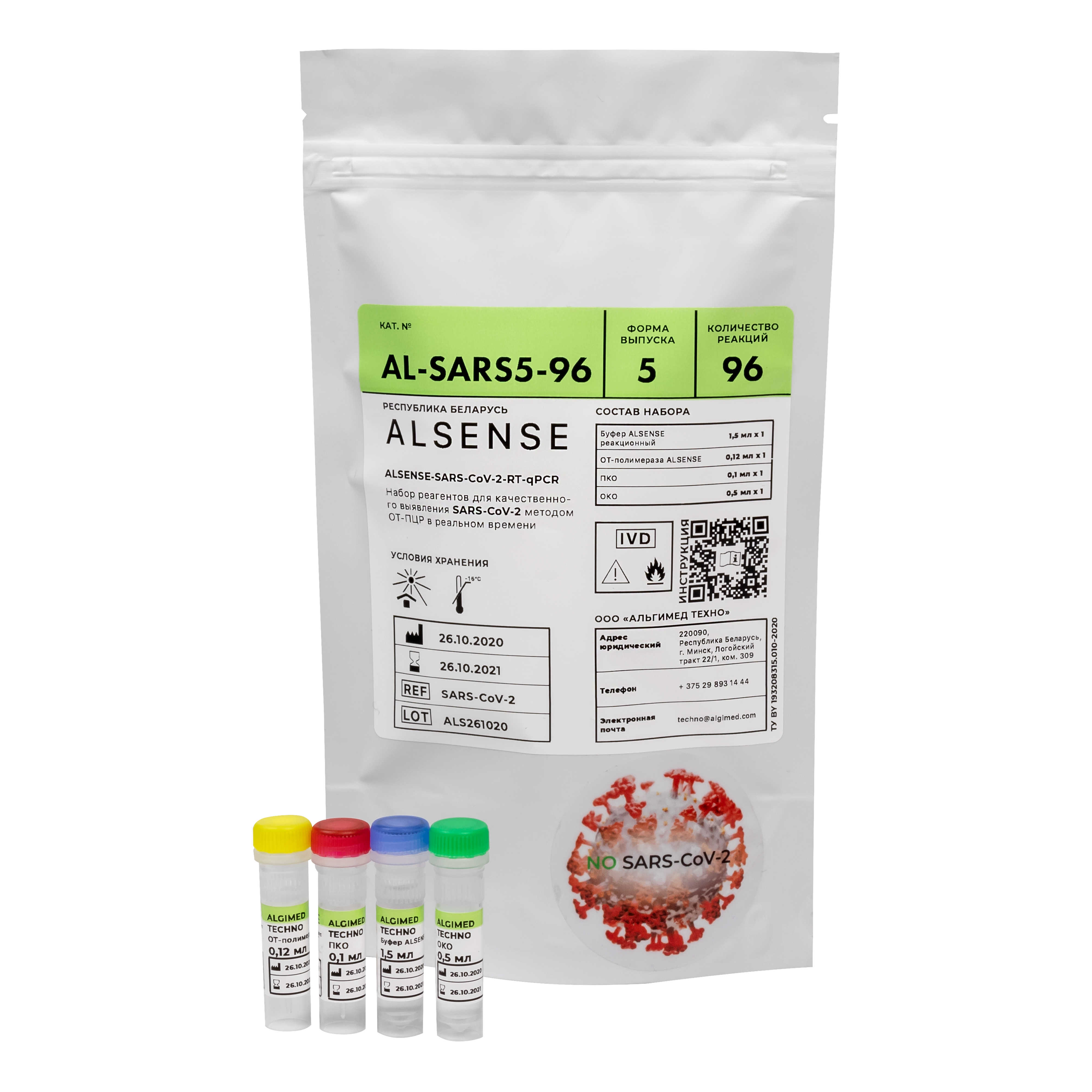
Набор реагентов «ALSENSE-SARS-CoV-2-RT-qPCR»
Набор реагентов «ALSENSE-SARS-CoV-2-RT-qPCR» разработан для клинической лабораторной диагностики и научно-исследовательской практики для качественного определения РНК коронавируса 2019-nCoV в клинических образцах.
Предназначен для выявления РНК коронавируса, в том числе «британского» (20I/501Y.V1, VOC 202012/01, или вариант « альфа» B.1.1.7), «южно-африканского» (20H/501Y.V2 или вариант «бета» B.1.351. и вариант «омикрон» B.1.1.529), а также «бразильского» штамма (вариант «гамма» P .1) и «индийского» (AY.1 или вариант «дельта» B.1.617.2,), “омикрон” (B.1.1.529). Применяется в клинической лабораторной диагностике и в научно-исследовательской практике для качественного определения РНК коронавируса 2019-nCoV в клинических образцах (назальный секрет, мазок из носоглотки, мазок из ротоглотки, мокрота и т.д.) в специализированных лабораториях учреждений медицины и здравоохранения.
Альгимед Техно
Минск
Produced in: Беларусь, Минск
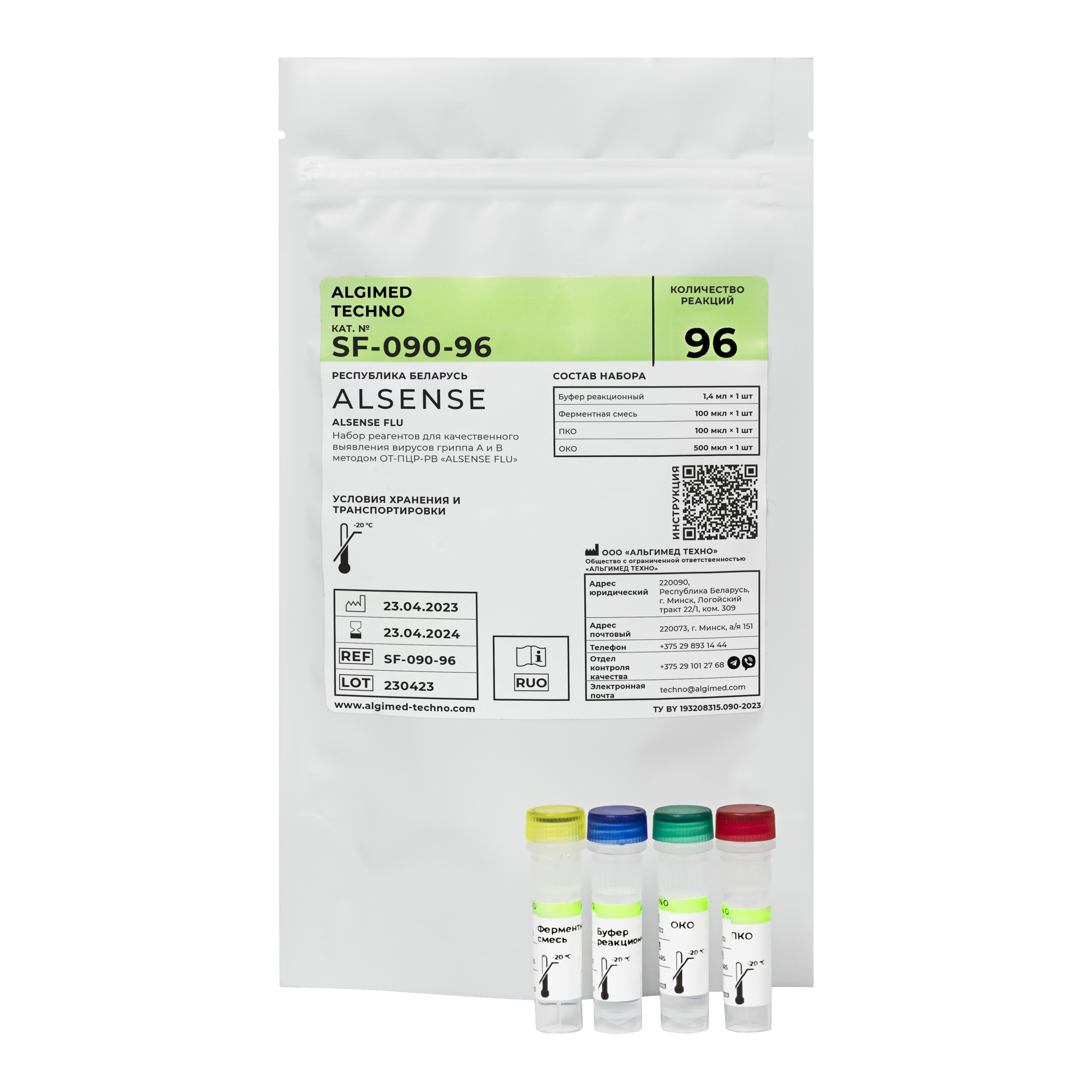
Набор реагентов «ALSENSE FLU»
Набор реагентов «ALSENSE FLU» предназначен для выявления РНК вирусов гриппа A и гриппа B методом одностадийной полимеразной цепной реакции с флуоресцентной детекцией в режиме реального времени (ОТ-ПЦР-РВ) в препаратах нуклеиновых кислот (НК) выделенных из клинических образцов (мазок из носоглотки, ротоглотки, бронхоальвеолярный лаваж, эндотрахеальный, назофарингеальный аспират, мокрота). Набор предназначен для применения только in vitro.
Альгимед Техно
Минск
Produced in: Беларусь, Минск
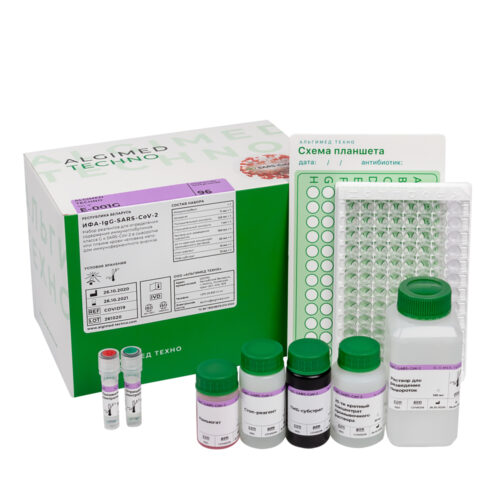
ИФА-набор для определения IgG к SARS-CoV‑2
Набор предназначен для качественного или полуколичественного определения содержания иммуноглобулинов класса G к SARS-CoV-2 в сыворотке или плазме крови человека методом иммуноферментного анализа. Набор предназначен для применения только in vitro.
Функциональные характеристики
- Диагностическая чувствительность: 96 %
- Диагностическая специфичность: 100%
Набор рассчитан на 96 определений, включая постановку в трипликате отрицательного контроля и в монопликате положительного контроля. Набор реагентов для определения IgG к нуклеокапсидному белку вируса SARS-CoV-2.
Альгимед Техно
Минск
Produced in: Беларусь, Минск

Набор реагентов «АЛМАСС Био», вариант исполнения «АЛМАСС Био Стандарт»
Набор реагентов «АЛМАСС Био», в варианте исполнения «АЛМАСС Био Стандарт» предназначен для подготовки образцов микроорганизмов 3-4 групп патогенности, выделенных из клинических образцов, при определении их видовой принадлежности, и для калибровки масс-спектрометров МАЛДИ-ВПМС в качестве вспомогательного средства диагностики in vitro инфекционных заболеваний населения.
Набор реагентов «АЛМАСС Био», в варианте исполнения «АЛМАСС Био Стандарт» содержит следующие компоненты: реагент «АЛМАСС Био Растворитель», реагент «АЛМАСС Био Стандарт»:
- Реагент «АЛМАСС Био Растворитель» является растворителем для реагента «АЛМАСС Био Стандарт».
- Реагент «АЛМАСС Био Стандарт» представляет собой очищенный белковый экстракт штамма Escherichia coli DH5 alpha, который демонстрирует при проведении масс-спектрометрического анализа типичный белковый профиль бактерии и применяется для калибровки масс.
Принцип метода:
Набор реагентов «АЛМАСС Био» применяется для калибровки масс по типовому белковому профилю бактерии Escherichia coli масс-спектрометра, входящего в состав системы для масс-спектрометрического анализа «АЛМАСС Био» (ООО «Альгимед Техно», РФ), и аналогичных масс-спектрометров МАЛДИ-ВПМС.
Состав набора:
Набор реагентов «АЛМАСС Био», вариант исполнения «АЛМАСС Био Стандарт» выпускается в комплектации, достаточной для проведения не менее 9000 идентификаций (не менее 630 точек нанесения реагента для калибровки), без добавления реагента «АЛМАСС Био Матрица»:
Часть 1:
Реагент «АЛМАСС Био Растворитель» – 1,2 мл x 1 виала.
Часть 2:
Реагент «АЛМАСС Био Стандарт» – 1 мг x 3 пробирки.
Примечание – количество идентификаций указано для калибровки масс при работе с системой для масс-спектрометрического анализа «АЛМАСС Био» по ТУ 26.60.12-008-57564538-2022 производства ООО «Альгимед Техно»; на масс-спектрометрах МАЛДИ-ВПМС иных производителей количество идентификаций может отличаться.
Альгимед Техно
Минск
Produced in: Москва
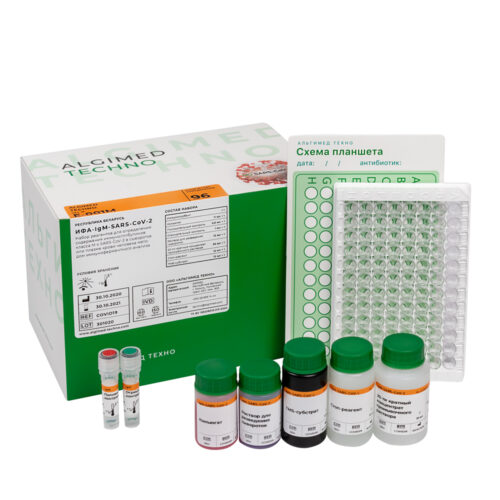
ИФА-набор для определения IgM к SARS-CoV‑2
Набор реагентов «ИФА-набор для определения IgМ к SARS-CoV‑2» предназначен для качественного или полуколичественного определения содержания иммуноглобулинов класса M к SARS-CoV-2 в сыворотке или плазме крови человека методом иммуноферментного анализа. Предназначен для применения только in vitro.
Набор рассчитан на 96 определений, включая постановку в трипликате отрицательного контроля и в монопликате положительного контроля. Набор реагентов для определения IgM к нуклеокапсидному белку вируса SARS-CoV-2.
Альгимед Техно
Минск
Produced in: Беларусь, Минск
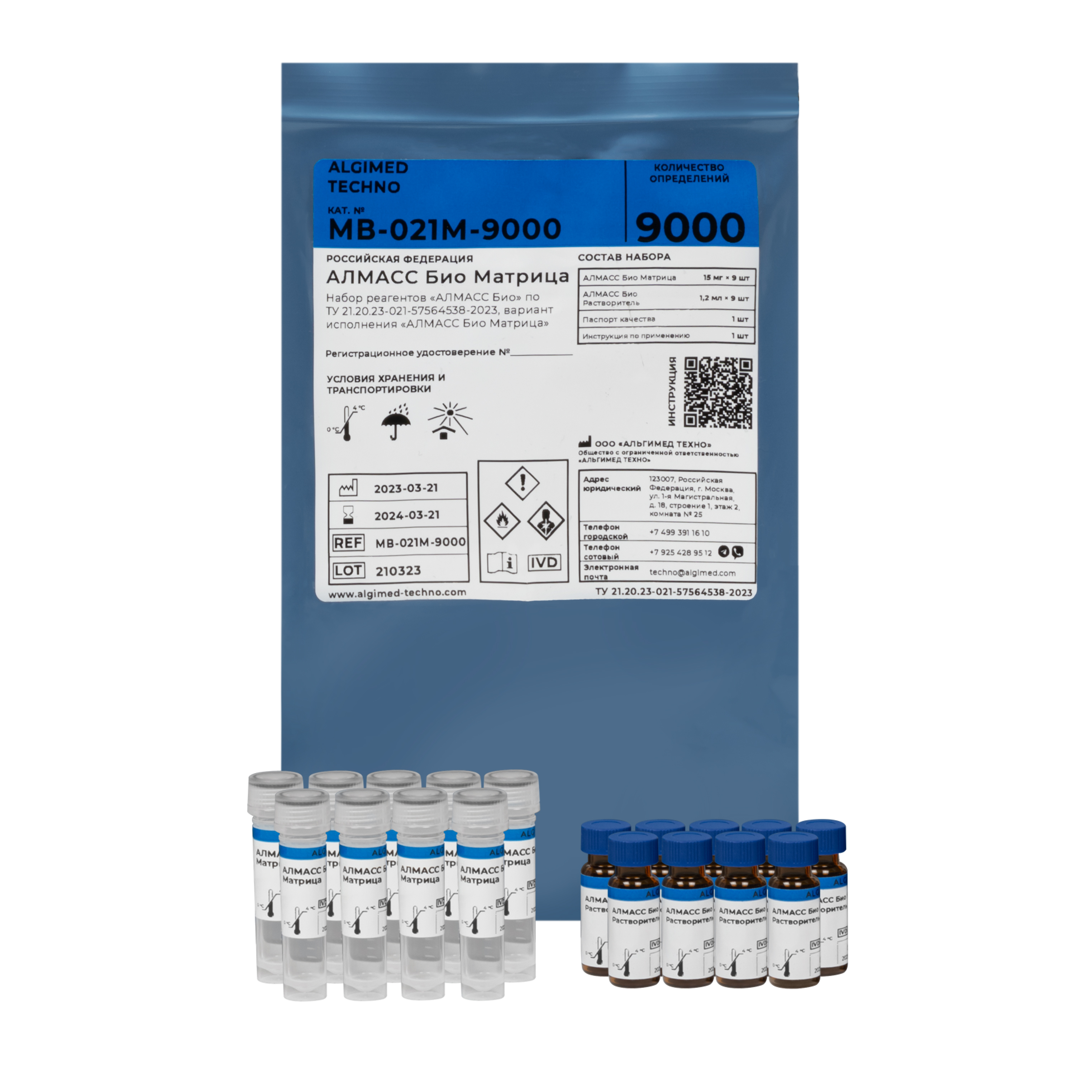
Набор реагентов «АЛМАСС Био», вариант исполнения «АЛМАСС Био Матрица»
Набор реагентов «АЛМАСС Био», в варианте исполнения «АЛМАСС Био Матрица» предназначен для подготовки образцов микроорганизмов 3-4 групп патогенности, выделенных из клинических образцов, при определении их видовой принадлежности, и для калибровки масс-спектрометров МАЛДИ-ВПМС в качестве вспомогательного средства диагностики in vitro инфекционных заболеваний населения.
Набор реагентов «АЛМАСС Био», в варианте исполнения «АЛМАСС Био Матрица» содержит следующие компоненты: реагент «АЛМАСС Био Растворитель», реагент «АЛМАСС Био Матрица»:
- Реагент «АЛМАСС Био Растворитель» является растворителем для реагента «АЛМАСС Био Матрица».
- Реагент «АЛМАСС Био Матрица» (α‑циано-4-гидроксикоричная кислота, CHCA) используется в качестве матрицы для реагента «АЛМАСС Био Стандарт» и анализируемых образцов, обеспечивая снижение деструктивного воздействия лазерного излучения при проведении анализа.
Принцип метода:
Принцип метода основан на обработке анализируемых образцов микроорганизмов снижающим деструктивные свойства лазерного излучения материалом (матрицей) и получении масс-спектров их белковых профилей.
Состав набора:
Набор реагентов «АЛМАСС Био», вариант исполнения «АЛМАСС Био Матрица» выпускается в комплектации, достаточной для проведения не менее 9000 идентификаций (не менее 9000 мкл рабочего раствора реагента «АЛМАСС Био Матрица»), без добавления реагента «АЛМАСС Био Стандарт»:
- Реагент «АЛМАСС Био Растворитель» – 1,2 мл x 9 виал;
- Реагент «АЛМАСС Био Матрица» – 15 мг x 9 пробирок.
Примечание – количество идентификаций указано для калибровки масс при работе с системой для масс-спектрометрического анализа «АЛМАСС Био» по ТУ 26.60.12-008-57564538-2022 производства ООО «Альгимед Техно»; на масс-спектрометрах МАЛДИ-ВПМС иных производителей количество идентификаций может отличаться.
Альгимед Техно
Минск
Produced in: Москва
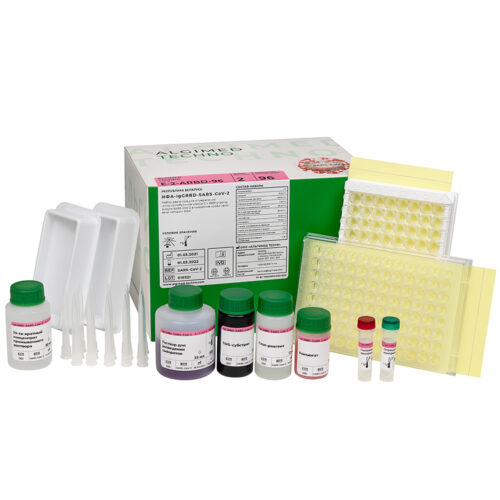
Набор «ИФА-IgGRBD-SARS-CoV‑2» на антитела IgG к RBD-участку S‑белка
ИФА-набор реагентов для полуколичественного определения IgG к рецептор-связывающему домену (RBD-участку) гликопротеина S (spike) коронавируса SARS-CoV‑2: «ИФА-IgG-RBD-SARS-CoV‑2».Набор «ИФА-IgG-RBD-SARS-CoV‑2» от производителя «Альгимед Техно» предназначен для применения только in vitro.
Специфические IgG к RBD-участку гликопротеина S вируса SARS-CoV-2 обладают вирус-нейтрализующей активностью благодаря блокированию связывания вируса с рецептором клеток человека ACE2. На основании сведений о содержании таких иммуноглобулинов в плазме крови пациентов можно делать выводы об:
- Оценке риска повторного заражения;
- Пригодности донорской плазмы к переливания пациентам с тяжелым течением коронавирусной инфекции;
- Эффективности вакцинации.
Альгимед Техно
Минск
Produced in: Беларусь, Минск
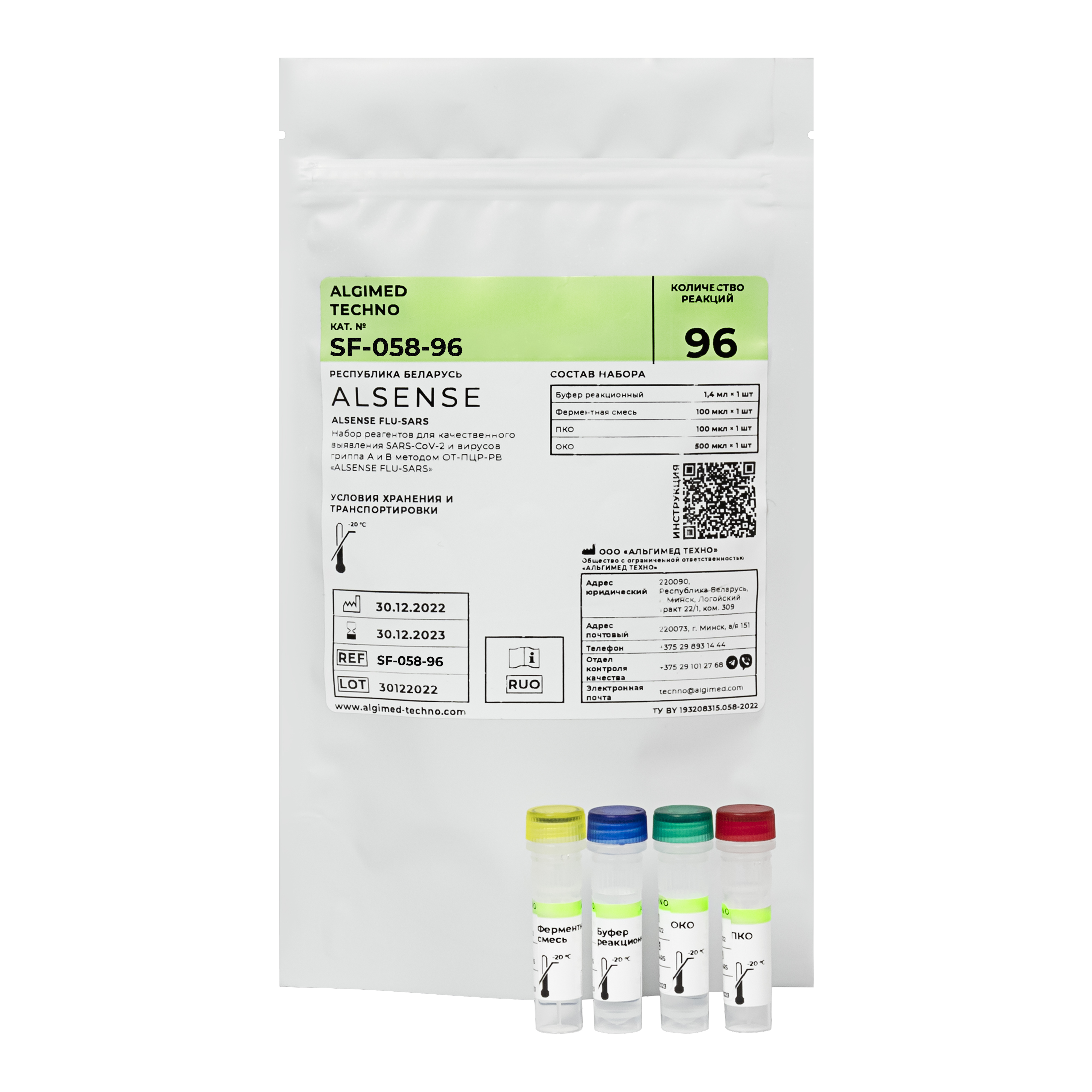
Набор реагентов «ALSENSE FLU-SARS»
Набор реагентов «ALSENSE FLU-SARS» предназначен для выявления РНК коронавируса SARS-CoV-2, вирусов гриппа A и гриппа B методом одностадийной полимеразной цепной реакции с флуоресцентной детекцией в режиме реального времени (ОТ-ПЦР-РВ) в препаратах нуклеиновых кислот выделенных из клинических образцов (мазок из носоглотки, ротоглотки, бронхоальвеолярный лаваж, эндотрахеальный, назофарингеальный мазок, мокрота).
Набор предназначен для применения только in vitro.
Альгимед Техно
Минск
Produced in: Беларусь, Минск
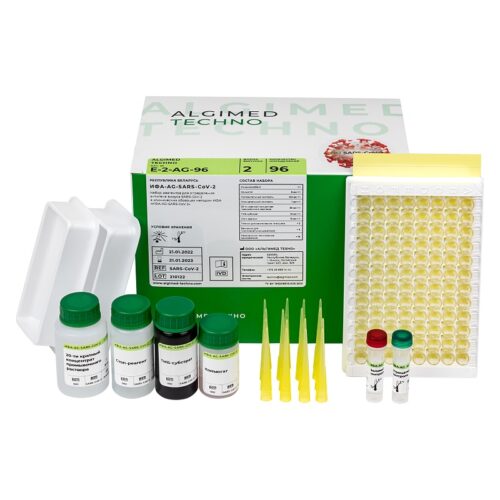
Набор «ИФА-AG-SARS-CoV‑2» для определения антигена вируса SARS-CoV‑2
Набор «ИФА-AG-SARS-CoV‑2» предназначен для определения антигена (нуклеокапсидного белка) вируса SARS CoV‑2 в клинических образцах (мазок из носоглотки, мазок из ротоглотки) с целью диагностики коронавирусной инфекции (КВИ), дифференциальной диагностики этиологии острой респираторной инфекции. Набор предназначен для применения только in vitro.
Альгимед Техно
Минск
Produced in: Беларусь, Минск
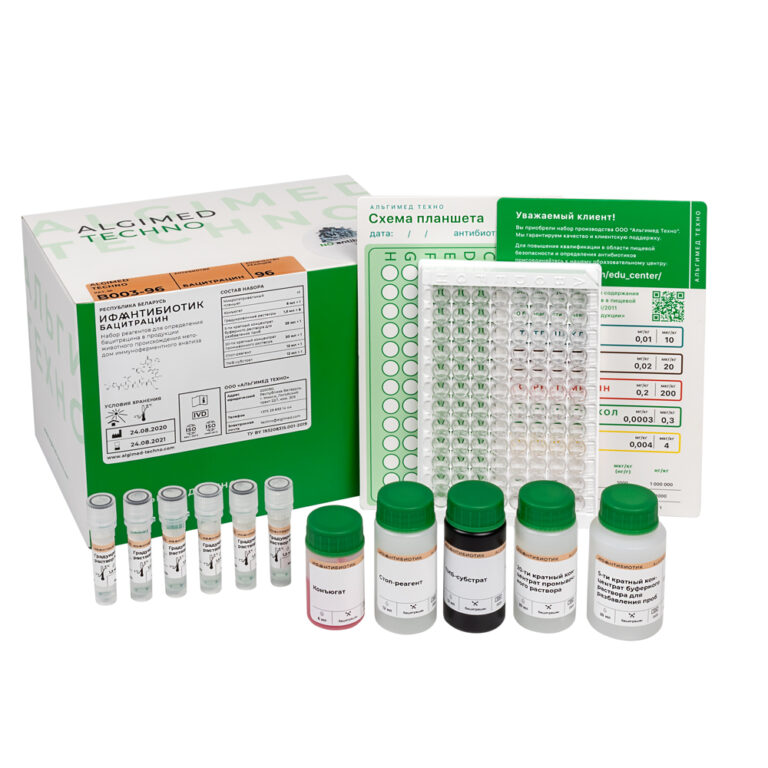
ИФА-набор «ИФА антибиотик-бацитрацин»
Набор предназначен для количественного определения содержания антибиотика бацитрацина методом конкурентного иммуноферментного анализа в следующих матрицах:
- молоко (сырое, пастеризованное, стерилизованное, ультрапастеризованное) и сухое восстановленное молоко;
- мясо (говядина, свинина, баранина, конина, птица), готовые к употреблению мясные и мясосодержащие продукты, полуфабрикаты мясные и мясорастительные, пищевая мясная и/или рыбная продукция для детского питания;
- субпродукты (в том числе птичьи), продукты содержащие субпродукты (в том числе птичьи), продукты переработки субпродуктов (в том числе птичьих), жиры животного происхождения (в том числе сало и шпик);
- яйца, яйцепродукты сухие и жидкие, продукты переработки яиц;
- продукция аквакультуры животного происхождения (рыба, креветки, икра), кулинарные изделия из рыбы, варено-мороженная пищевая рыбная продукция, рыбные консервы и пресервы;
- корма (комбикорм, мясо-костная мука);
- мед.
Набор предназначен для применения только in vitro.
Альгимед Техно
Минск
Produced in: Беларусь, Минск
Reviews
There are no entries.

